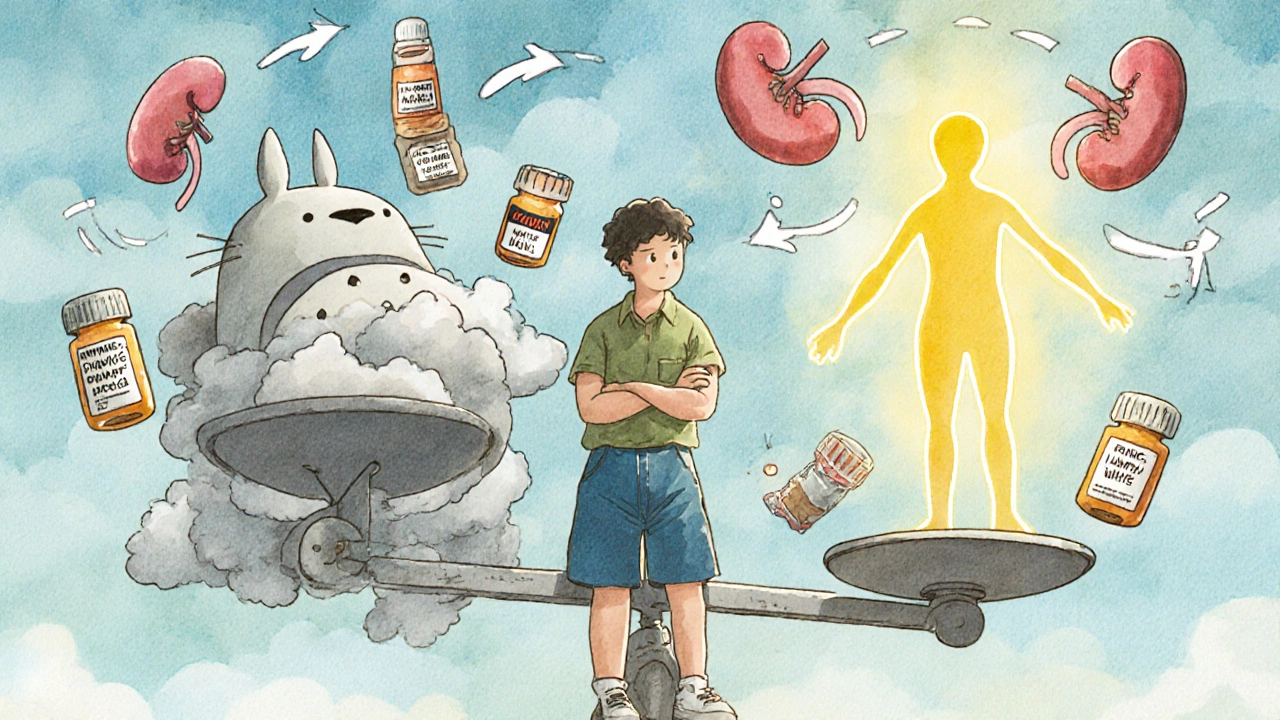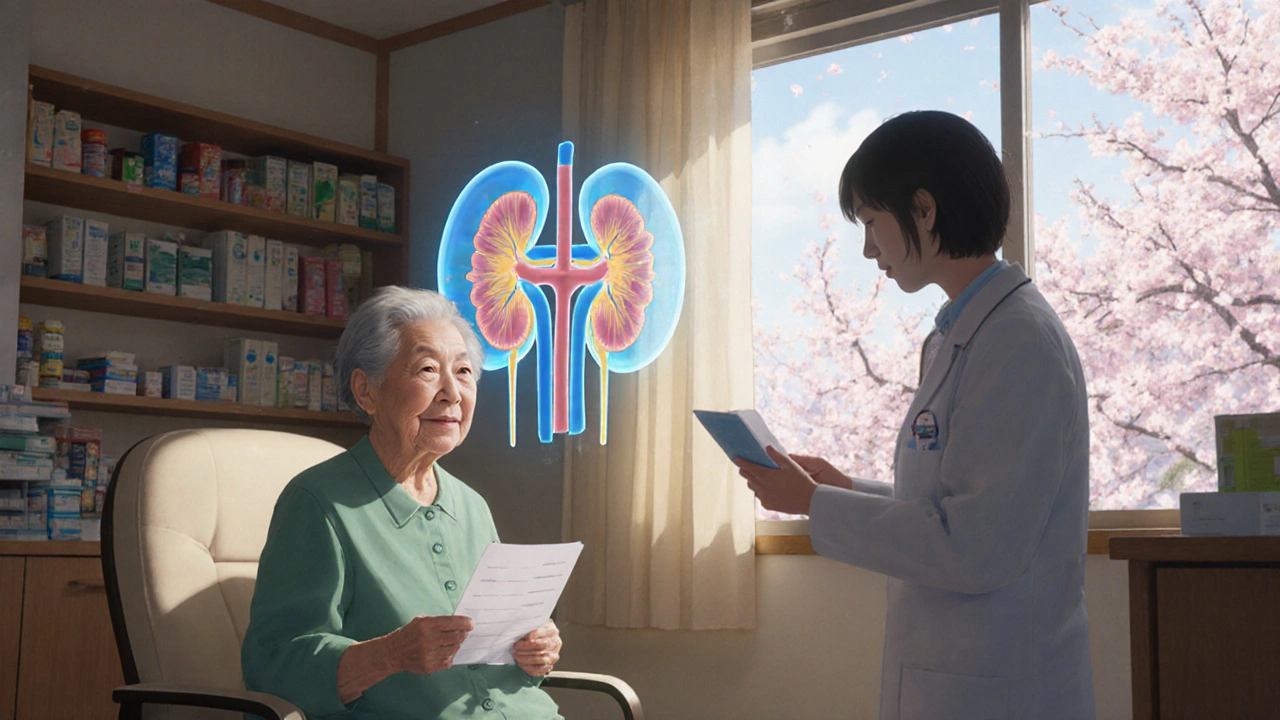Getting the right dose of medicine isn’t just about what’s written on the prescription label. For many people, especially older adults, those with chronic kidney disease, or individuals who are very thin or overweight, the standard dose can be too much-or too little. Too much can cause dangerous side effects. Too little means the medicine won’t work. That’s why medication dosing must be adjusted based on age, weight, and kidney function. This isn’t optional. It’s a safety requirement. Most people assume their doctor or pharmacist already handles this. But studies show nearly 70% of pharmacists report seeing incorrect kidney-based dosing at least once a week. And in hospitals, up to 30% of adverse drug events in older patients are linked to improper dosing. This isn’t a rare mistake. It’s a widespread, preventable problem. Let’s break down exactly how these three factors change how your medicine works-and what you can do to make sure you’re getting the right amount.
How Kidney Function Changes Everything
Your kidneys don’t just make urine. They filter your blood and remove many medications from your body. When kidney function drops, those drugs build up. That’s why drugs like metformin, vancomycin, or certain blood pressure pills can become toxic if the dose isn’t lowered. Doctors don’t just look at your serum creatinine level. They calculate your estimated glomerular filtration rate, or eGFR. This number tells them how well your kidneys are filtering. The standard formula used today is called CKD-EPI, which takes into account your age, sex, race, and creatinine level. It’s more accurate than older methods, especially for people with normal or near-normal kidney function. But here’s the catch: for dosing medicines, many guidelines still rely on creatinine clearance (CrCl), not eGFR. Why? Because most drug dosing recommendations were developed using CrCl calculations from the 1980s and 90s. The Cockcroft-Gault equation is still used in 85% of FDA drug labels. The Cockcroft-Gault formula looks like this: (140 - age) × weight (kg) × 0.85 (if female) ÷ (serum creatinine × 72) It gives you CrCl in mL/min. That number is what’s used to adjust doses. If your CrCl is below 60 mL/min, most drugs need some kind of change. Below 30 mL/min, almost all renally cleared drugs need major adjustments. The problem? eGFR and CrCl often give different numbers. A person with eGFR of 45 might have a CrCl of 32. That’s a big difference when deciding whether to cut a dose in half or stop a drug entirely.Why Weight Matters-More Than You Think
Weight isn’t just about being overweight. It’s about how much drug your body can hold and how fast it clears it. For someone who’s underweight (BMI under 18.5), standard doses can be too high. Their smaller body size means less space for the drug to spread out, and their kidneys may clear it faster than expected. The result? Higher blood levels, more side effects. For someone who’s obese (BMI over 30), the opposite happens. Many drugs get stored in fat tissue, so using total body weight leads to overestimating kidney clearance. That’s why doctors use something called adjusted body weight: Adjusted weight = ideal body weight + 0.4 × (actual weight - ideal body weight) Ideal body weight is calculated differently for men and women: - Men: 50 kg + 2.3 kg for each inch over 5 feet - Women: 45.5 kg + 2.3 kg for each inch over 5 feet Using total body weight for dosing in obese patients can lead to underdosing. A 2019 study found that eGFR equations overestimate kidney function by 15-20% in obese people. That means if your doctor uses eGFR alone to adjust your dose, you might get too little of your antibiotic or painkiller. For drugs like vancomycin or antibiotics used in sepsis, underdosing can be life-threatening. One pharmacist on Reddit shared a near-miss where a patient was on 1000 mg of metformin twice daily with an eGFR of 28. The FDA label says max is 500 mg daily. That patient had been on it for six months.Age Isn’t Just a Number
As you get older, your kidneys naturally slow down-even if you’re healthy. Muscle mass declines, creatinine production drops, and kidney blood flow decreases. All of this means drugs stick around longer. The CKD-EPI equation accounts for age, but the Cockcroft-Gault equation does too. That’s why older adults are at higher risk. A 2017 study found that 65% of elderly patients had eGFR values within 30% of their actual kidney function, compared to only 45% with Cockcroft-Gault. So for older people, eGFR is more accurate for staging kidney disease-but CrCl is still needed for dosing. This creates confusion. A 72-year-old with an eGFR of 50 might seem to have Stage 3a CKD. But their CrCl might be 38. That’s Stage 4. One number says “watch,” the other says “change now.” Many common drugs need dose reductions starting at age 65, even if kidney function seems okay. Painkillers like acetaminophen, sleep aids like zolpidem, and heart medications like digoxin all have age-based warnings. Yet, a 2022 survey found that only 58% of emergency medicine doctors routinely check renal function in patients over 65.
What You Should Do
You don’t need to calculate CrCl yourself. But you can ask the right questions. Ask your doctor or pharmacist:- “Is my kidney function being checked?”
- “Is my dose adjusted based on my kidneys, not just my age or weight?”
- “Are you using creatinine clearance or eGFR to decide my dose?”
- “Does this medicine need a different dose if I’m overweight or underweight?”
Common Mistakes and How to Avoid Them
Here are the top errors-and how to spot them:- Using eGFR for dosing: Many online tools and EHRs default to eGFR. Ask if they’re using CrCl for medication adjustments.
- Using total body weight in obese patients: If you’re overweight and on antibiotics, insulin, or seizure meds, ask if they used adjusted weight.
- Ignoring weight in thin patients: If you’re underweight and on blood thinners or psychiatric meds, your dose may be too high.
- Assuming age alone means lower dose: Some 70-year-olds have perfect kidneys. Some 50-year-olds have Stage 4 CKD. It’s not about age-it’s about function.

What’s Changing in 2025
The field is moving fast. In 2025, a new standardized renal dosing database from the American Society of Nephrology and the American Society of Health-System Pharmacists will launch. It’s meant to fix the confusion between different drug guides. The FDA is also pushing for more precise dosing. Their 2023 draft guidance recommends combining renal function tests with therapeutic drug monitoring-especially for drugs like vancomycin, lithium, and digoxin. That means blood tests to check actual drug levels, not just guesses based on kidney numbers. And in the future? Wearable sensors that measure real-time kidney filtration could replace calculations altogether. The NIH is funding pilot studies for this tech, with trials starting in late 2024. For now, though, the system is still human-run. And that means you need to be part of the team.When to Worry
If you’re on any of these drugs and have kidney disease, weight issues, or are over 65, watch for these signs:- Confusion, dizziness, or extreme fatigue (signs of drug buildup)
- Nausea, vomiting, or diarrhea (common with metformin or antibiotics)
- Unusual bleeding or bruising (warfarin, aspirin)
- Seizures or tremors (antibiotics like ciprofloxacin, seizure meds)
Bottom Line
Medication dosing isn’t one-size-fits-all. Your kidneys, your weight, and your age all change how your body handles medicine. Ignoring these factors isn’t just outdated-it’s dangerous. You don’t need to be a doctor to protect yourself. Ask questions. Know your numbers. Keep a list of your meds. Speak up if something feels off. Your life might depend on it.How do I know if my medication dose needs to be adjusted for my kidneys?
Your doctor or pharmacist should check your kidney function with a blood test (serum creatinine) and calculate your creatinine clearance (CrCl) using the Cockcroft-Gault equation, especially if you’re over 65, overweight, or have diabetes or high blood pressure. If your CrCl is below 60 mL/min, most drugs need adjustment. Ask them which formula they used and whether they’re using CrCl or eGFR for dosing-CrCl is what matters for medication changes.
Should I use my actual weight or ideal weight for dosing calculations?
If your BMI is over 30 (obese), use adjusted body weight-not your actual weight. If your BMI is under 18.5 (underweight), your dose may need to be lowered regardless of kidney function. For people with normal weight, actual weight is fine. Always ask your pharmacist which weight they used, especially for antibiotics, insulin, or seizure medications.
Why do some sources say to reduce my dose by 50% and others say 75%?
There’s no universal standard yet. Different drug guides (Lexicomp, Micromedex, hospital formularies) use different data. A 2023 study found 38% of antibiotic dosing guidelines contradict each other. Always ask your pharmacist which source they follow. If you’re unsure, ask them to check the FDA-approved drug label-it’s the most reliable source.
Can I trust my EHR to adjust my doses automatically?
Electronic health records can help-they flag risky prescriptions and reduce errors by nearly half. But they’re not perfect. Some systems use eGFR instead of CrCl. Others use total weight in obese patients. Always double-check the suggested dose against your actual numbers. If the system says “no adjustment needed” but your CrCl is 25, speak up.
What if I’m on multiple medications? Do I need to check all of them?
Yes. About 40-60% of commonly prescribed drugs require kidney-based adjustments. That includes painkillers, antibiotics, diabetes meds, heart drugs, and antidepressants. A 2022 survey found that 68% of pharmacists see at least one wrong renal dose per week. Don’t assume one safe dose means all are safe. Get a full medication review at least once a year if you have kidney disease or are over 65.


This post is basically a public service announcement disguised as a medical article. I printed it out and taped it to my fridge next to my meds. If you're on more than three prescriptions and over 50, you're basically playing Russian roulette with your kidneys.
I'm a pharmacist and I see this every single day. The worst part? Patients don't even know to ask. I had a 78-year-old woman on metformin 1000mg BID with an eGFR of 24. She didn't know what eGFR stood for. I had to explain it like she was 12. She cried. Then she thanked me. This isn't just clinical-it's emotional labor.
Doctors don't have time. Pharmacies are understaffed. Patients are overwhelmed. But if you're on renal-clearing drugs, you owe it to yourself to ask: 'Which number are you using? CrCl or eGFR?' If they hesitate, walk out and find someone who knows.
It is of paramount importance to recognize that the Cockcroft-Gault equation, despite its antiquated derivation, remains the gold standard for pharmaceutical dosing adjustments in the majority of institutional settings. The reliance upon eGFR for this purpose constitutes a significant departure from evidence-based practice, and may result in iatrogenic harm. One must exercise extreme caution when interpreting renal function metrics in clinical decision-making.
I love how this breaks it down without making you feel stupid. I'm 62 and on three meds-two of them got adjusted after I asked my pharmacist to check my CrCl. I didn't know I could ask that. Turns out, I can. And I should. Thanks for reminding us we're not just passive recipients of prescriptions.
Let’s be real-this is just another way for the pharmaceutical industry to sell more lab tests. eGFR? CrCl? Adjusted body weight? You’re just being manipulated into thinking you need more monitoring. The truth? Most people are fine. Your body knows how to handle medicine. Stop overthinking it.
I used to think my doctor knew everything. Then I got my dad’s meds reviewed after his fall. Turned out his blood thinner dose hadn’t been touched in 4 years-even though his CrCl dropped from 70 to 31. He almost bled out. Don’t assume. Ask. Even if it feels awkward. It’s your life.
Wow. Another article telling people they’re too dumb to manage their own meds. Newsflash: If you’re old, fat, or sick, you’re a liability to the system. Maybe we should stop giving pills to people who can’t do the math. Just sayin’. Your kidneys aren’t a magic box. They’re a failing organ. Accept it. Stop demanding adjustments.
They're hiding the truth. The real reason they use CrCl? It's because the government pays them less if they use eGFR. And the weight thing? They're scared if they admit fat people need different doses, insurance won't cover it. This is all a scam. I know someone who works at the FDA-they told me.
From a nephrology research perspective, the persistent reliance on Cockcroft-Gault for pharmacokinetic modeling is a critical anachronism. The CKD-EPI equation demonstrates superior accuracy in GFR estimation, particularly in non-uremic populations. The disconnect between dosing guidelines and contemporary renal physiology reflects a systemic lag in translational medicine implementation. Further, the use of adjusted body weight in obese cohorts remains contentious due to inter-individual variability in fat mass distribution and altered volume of distribution for lipophilic agents.
MY DOCTOR DIDN'T DO THIS AND NOW I'M HAVING SIDE EFFECTS 😭😭😭 I'M SO ANGRY I'M CRYING RIGHT NOW AND MY KIDNEYS ARE ON FIRE 🥺💊 #MedicationEmergency #SaveMyLife
Why are you telling people to ask questions? That’s not your job. They should’ve been taught this in school. Now they’re burdening busy clinicians with basic inquiries. It’s irresponsible to empower patients like this. Let professionals do their jobs.
I’m 54, overweight, diabetic, and on 7 meds. I asked my pharmacist about CrCl. He looked at me like I asked him to perform brain surgery. Then he said, 'We just follow the computer.' I cried in the parking lot. I’m not a number. I’m not a BMI. I’m not a lab result. I’m a person who just wants to live without feeling like poison is running through my veins.
Thank you for writing this with such clarity. I’m a geriatric nurse and I’ve seen too many patients harmed by default dosing. The most heartbreaking part? The ones who don’t speak up. They think asking is rude. It’s not. It’s survival. Please share this with your parents, your aunts, your neighbors. Someone’s life depends on it.